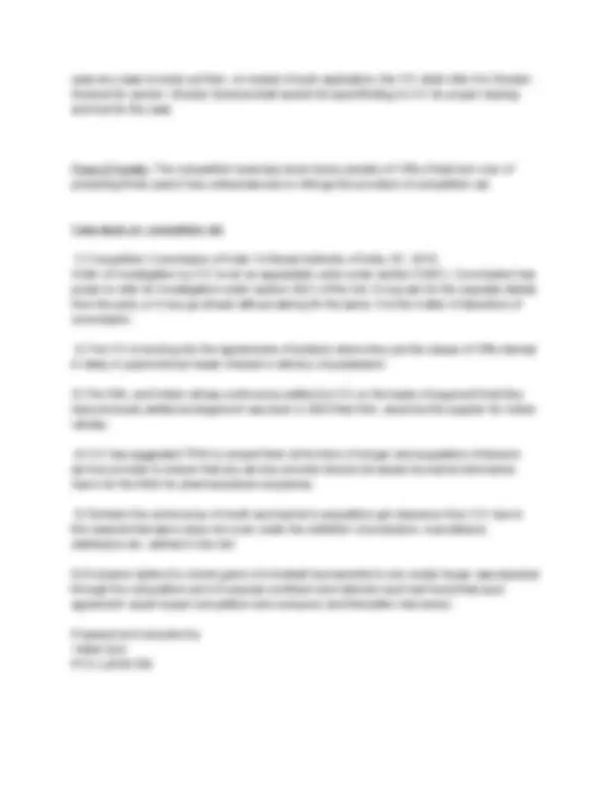



Study with the several resources on Docsity

Earn points by helping other students or get them with a premium plan


Prepare for your exams
Study with the several resources on Docsity

Earn points to download
Earn points by helping other students or get them with a premium plan
Community
Ask the community for help and clear up your study doubts
Discover the best universities in your country according to Docsity users
Free resources
Download our free guides on studying techniques, anxiety management strategies, and thesis advice from Docsity tutors
Competition act brief (2).pdf
Typology: Lecture notes
1 / 3

This page cannot be seen from the preview
Don't miss anything!


Competition Act 2002
-Competition Act 2002 which further amended by amendment act 2007 and 2009, the modified version on an Act which we earlier use to know by the name of MRTP Act 1969. -MRTP Act 1969 is repealed by the virtue of section 66 as amended through the act of 2007. MRTP commission wound up. -It is business law which control the fair competition in the market. This law prohibits the practice of price fixing among market players which it termed as enterprise. -This law ensure that a dominant player should not abuse its dominant position in the market. -It disallow all the agreements with a are anti competitive in nature. -It has brought the concept of ‘combination’ where on person who own a competitor enterprise can not get merger/amalgamation in a way which adversely affect the competition. -This law constitutes a statutory body competition commission of india (CCI) which is fully functional from May 2009. CCI has vide powers to enter into the matters of the Act even without any application to it. -This act is directly affect to the top management of the company. It assume that the pricing and trade associations are in knowledge of top management. -It lays down heavy penalty of the offense under this act. Appellate tribunal is constituted to file appeal against the order of competition commission.
Objectives of CCI:
i. Anti-Competitive Agreements:
This covers both the horizontal and vertical agreements. It states that four types of horizontal agreements between enterprises involved in the same industry would be applied.
These agreements are those that:
(i) lead to price fixing; (ii) limit or control quantities; (iii) share or divide markets; and (iv) result in bid-rigging.
ii. Abuse of Dominance: The Act lists five categories of abuse:
(i) imposing unfair/discriminatory conditions in purchase of sale of goods or services (including predatory pricing); (ii) limiting or restricting production, or technical or scientific development; (iii) denial of market access;
(iv) making any contract subject to obligations unrelated to the subject of the contract; and (v) using a dominant position in one market to enter or protect another.
iii. Combinations Regulation (Merger and Amalgamation):
The Act states that any combination that exceeds the threshold limits in terms of value of assets or turnover can be scrutinised by the CCI to determine whether it will cause or is likely to cause an appreciable adverse effect on competition within the relevant market in India.
iv. Enforcement:
The CCI, the authority entrusted with the power to enforce the provisions of the Act, can enquire into possibly anticompetitive agreements or abuse of dominance either on its own initiative or on receipt of a complaint or information from any person, consumer, consumers association, a trade association or on a reference by any statutory authority. -It can issue ‘cease and desist’ orders and impose penalties. The CCI can also order the break-up of a dominant firm.
The new competition law in India, despite some concerns expressed in certain quarters, is much more consistent with the current antitrust thinking than the outgoing MRTP Act. Although the success of the new Indian model will now turn on its implementation, India would appear to have taken a very substantial step towards the adoption of a modern competition policy. Competition law is equally applicable on written as well as oral agreement, arrangements between the enterprises.
Competition Advocacy:
Competition advocacy is one of the most significant feature in the Act. It is the obligation of commission to create the awareness about the competition laws through non-enforcement measures. It also includes training programs, seminar, educational workshops.
Remedies under the competition laws of India
Competition Commission of India is the statutory body to approach for unfair competition practices. The relevant Act is Competition Act 2002 and its amendment act 2007. CCI has power to act suo-mot or on the reference from Government. Consumer can directly approach the CCI by filling an application with 5000/- prescribed fees in case of individual/huf/ngos. In